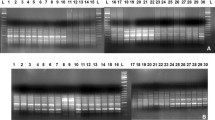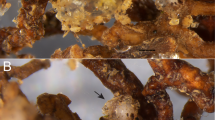Abstract
In order to expand our understanding of the genetics of root-knot nematodes, variation in nuclear DNA and mitochondrial DNA in Meloidogyne incognita, M. arenaria and M. javanica was investigated. Despite the obligate mitotic parthenogenetic mode of reproduction, a large number of AFLP polymorphisms were observed among all 16 populations studied. Both UPGMA and principle coordinate analyses revealed three distinct groups that corresponded with the respective species identities of the 16 populations. M. incognita was genetically most distinct. Amplification of 63-bp tandem repeats (TR) in mtDNA from single individuals enabled the calculation of diversity measures at three hierarchical levels: within individuals, among individuals of a single population and among populations. For all three species, the highest diversity was observed within individuals explaining 43–65% of the total diversity. Many individuals contained more than one mtDNA size variant. M. incognita harboured the most heteroplasmic individuals and was the most homogenous at the population level. Only 13% of the total diversity was observed among populations, while this figure was 35% for M. arenaria. Both TR and AFLP data showed that M. arenaria is the most heterogeneous species. The comparison of the genetic distances based on AFLPs and mtDNA size variants revealed a significant correlation for the six M. arenaria populations, whereas no consistent correlation was observed for the populations of the other two species.
Similar content being viewed by others
References
Arnason E and Rand DM (1992) Heteroplasmy of short tandem repeats in mitochondrial DNA of atlantic cod, Gadus morhua. Genetics 132: 211–220
Avise JC (1994) Molecular Markers, Natural History and Evolution. Chapman Hall, New York
Azevedo JLB and Hyman BC (1992) Molecular characterization of lengthy mitochondrial DNA duplications from the parasitic nematode Romanomermis culicivorax. Genetics 133: 933–942
Baum TJ, Gresshoff PM, Lewis SA and Dean RA (1994) Characterization and phylogenetic analysis of four root knot nematode species using DNA amplification fingerprinting and automated polyacrylamide gel electrophoresis. Molecular Plant—Microbe Interaction 7: 39–47
Birky CW, Fuerst P and Maruyama T (1989) Organelle gene diversity under migration, mutation, and drift: equilibrium expectations, approach to equilibrium, effects of heteroplasmic cells, and comparison to nuclear genes. Genetics 121: 613–627
Blok VC, Phillips MS, McNicol JW and Fargette M (1997) Genetic variation in tropical Meloidogyne spp. as shown by RAPDs. Fundamental and Applied Nematology 20: 127–133
Blouin MS, Dame JB, Tarrant CA and Courtney CH (1992) Unusual population genetics of a parasitic nematode mtDNA variation within and among populations. Evolution 46: 470–476
Carpenter AS, Haitt EE, Lewis SA and Abbot AG (1992) Genomic RFLP analysis of Meloidogyne arenaria race 2 populations. Journal of Nematology 24: 23–38
Castagnone-Sereno P, Vanlerberghe-Masutti F and Laroy F (1994) Genetic polymorphism between and within Meloidogyne species detected with RAPD markers. Genome 37: 904–909
Caswell EP and Roberts PA (1987) Nematode population genetics. In: Veech JA and Dickson DW (eds) Vistas on Nematology (pp 390–397) Society of Nematologists Inc, Hyattsville, Maryland
Cenis JL (1993) Identification of four major Meloidogyne spp. by random amplified polymorphic DNA (RAPD-PCR). Phytopathology 83: 76–78
Denver DR, Morris K, Lynch M, Vassilieva LL and Thomas WK (2000) High direct estimate of the mutation rate in the mitochondrial genome of Caenorhabditis elegans. Science 289: 2342–2344
Esbenshade PR and Trintaphyllou AC (1990) Isozyme phenotypes for the identification of Meloidogyne species. Journal of Nematology 22: 10–15
Fargette M, Blok VC, Phillips MS and Trudgill DL (1994) Genetic variation in tropical Meloidogyne species. In: Lamberti F, De Giorgi C and Bird DMcK (eds) Advances in Molecular Plant Nematology (pp 91–96) Plenum Press, New York
Felsenstein J (1985) Confidence limits on phylogenies: an approach using the bootstrap. Evolution 39: 783–791
Folkertsma RT, Rouppe van der Voort JNAM, De Groot KE, van Zandvoort PM, Schots A, Gommers FJ, Helder J and Bakker J (1996) Gene pool similarities of potato cyst nematode populations assessed by AFLP analysis. Molecular Plant— Microbe Interaction 9: 47–54
Gárate T, Robinson MP, Chacón MR and Parkhouse ME (1991) Characterization of species and races of the genus Meloidogyne by DNA restriction enzyme analysis. Journal of Nematology 23: 414–420
Guirao P, Moya A and Cenis L (1995) Optimal use of random polymorphicDNAin estimating the genetic relationship of four major Meloidogyne spp. Phytopathology 85: 547–551
Hale LR and Singh RS (1986) Extensive variation and heteroplasmy in size of mitochondrial DNA among geographical populations of Drosophila melanogaster. Proceedings of the National Academy of Sciences of the United States of America 83: 8813–8817
Hugall A, Moritz C, Stanton J and Wolstenholme DR (1994) Low, but strongly structured mitochondrial DNA diversity in root knot nematodes (Meloidogyne). Genetics 136: 903–912
Hussey RS and Barker KR (1973) A comparison of methods of collecting inocula of Meloidogyne spp., including a new technique. Plant Disease Reporter 57, 1025–1028
Hyman BC (1988) Nematode mitochondrial DNA: anomalies and applications. Journal of Nematology 20: 523
Hyman BC and Slater TM (1990) Recent appearance and molecular characterization of mitochondrial DNA deletions within a defined nematode pedigree. Genetics 124: 845–853
Hyman BC and Whipple LE (1996) Application and mitochondrial DNA polymorphism to Meloidogyne molecular population biology. Journal of Nematology 28: 268–276
Lapp NA and Triantaphyllou AC (1972) Relative DNA content and chromosomal relationships of some Meloidogyne, Heterodera, and Meloidodera spp. (Nematoda: Heteroderidae). Journal of Nematology 4: 287–290
Lunt HD and Hyman CB (1997) Animal mitochondrial DNA recombination. Nature 387: 247
Lunt HD, Whipple EL and Hyman CB (1998) Mitochondrial DNA variable number tandem repeats (VNTRs): utility and problems in molecular ecology. Molecular Ecology 7: 1441–1455
Lynch M and Milligan BG (1994) Analysis of population genetic structure with RAPD markers. Molecular Ecology 3: 91–99
Maniatis T, Fritsch EF and Sambrook J (1982) Molecular Cloning: a Laboratory Manual. Cold Spring Harbor Laboratory, Cold Spring Harbor, New York
Monnerot M, Mounolou JC and Solignac M (1984) Intra-individual length heterogeneity of Rana esculenta mitochondrial DNA. Cell Biology 52: 213–218
Nei M and Li WS (1979) Mathematical model for stating genetic variation in terms of restriction endonucleases. Proceedings of the National Academy of Sciences of the Unated States of America 76: 5269–5273
Noe JP (1992) Variability among populations of Meloidogyne arenaria. Journal of Nematology 24: 404–414
Okimoto R, Chamberlin HM, Macfarlane JL and Wolstenholme DR (1991) Repeated sequence sets in mitochondrial DNA molecules of root knot nematodes (Meloidogyne): nucleotide sequences, genome location and potential for hostrace identification. Nucleic Acids Research 19: 1619–1626
Powers TO and Sandall LJ (1988) Estimation of genetic divergence in Meloidogyne mitochondrial DNA. Journal of Nematology 20: 288–293
Powers TO and Harris TS (1993) A polymerase chain reaction method for identification of five major Meloidogyne species. Journal of Nematology 25: 1–6
Rand DM and Harrison RG (1986) Mitochondrial DNA transmission genetics in crickets. Genetics 114: 955–970
Rand DM and Harrison RG (1989) Molecular population genetics of mtDNA size variation in crickets. Genetics 121: 551–569
Rohlf FJ (1989) NTSYS-pc Numerical Taxonomy and Multivariate Analysis System, Version 1.80. Exeter Publication, New York
Sambrook J, Fritsch EF and Maniatis T (1989) Molecular Cloning: A Laboratory Manual, 2nd edn, Cold Spring Harbor Laboratory, Cold Spring Harbor, New York
SAS Institute Inc (1987) SAS/STAT Guide for Personal Computers. Version 6 (edn). SAS Institute Inc, Gary, NC
Semblat J-P, Wajnberg E, Dalmasso A, Abad P and Castagnone-Sereno P (1998) High-resolution DNA finger-printing of parthenogenetic root-knot nematodes using AFLP analysis. Molecular Ecology 7: 119–125
Sneath PHA and Sokal RR (1973) Numerical Taxonomy: The Principles and Practice of Numerical Classification. WH Freeman and Company, California
Sokal RR and Rohlf FJ (1981) Biometry. WH Freeman and Company, New York
Tastet C, Bossis M, Renault L and Mugnikry D (2000) Protein variation in tropical Meloidogyne spp. as shown by two-dimensional electrophoregram computed analysis. Nematology 2: 343–353
Taylor AL and Sasser JN (1978) Biology, identification and control of root-knot nematodes (Meloidogyne species). Department of Plant Pathology, North Carolina State University/ United States Agency for International Development, Raleigh, North Carolina
Triantaphyllou AC (1981) Oogenesis and the chromosomes of the parthenogenetic root-knot nematode Meloidogyne incognita. Journal of Nematology 13: 95–104
Tzortzakakis EA, Blok VC, Phillips MS and Trudgill DL (1999) Variation in root knot nematode (Meloidogyne spp.) in Crete in relation to control with resistant tomato and pepper. Nematology 1: 499–506
van De Peer Y and De Wachter R (1993) TREECON: a software package for the construction and drawing of evolutionary trees. Computer Application in the Biosciences 9: 177–182
van der Beek JG, Folkertsma R, Zijlstra C, van Koert PHG, Poleij LM and Bakker J (1998) Genetic variation among parthenogenetic Meloidogyne species revealed by AFLP and 2D-protein electrophoresis contrasted to morphology. Fundamental and Applied Nematology 21: 401–411
van Eck HJ, Rouppe van der Voort J, Draaistra J, van Zandvoort P, van Enckevort E, Segers B, Peleman J, Jacobsen E, Helder J and Bakker J (1995) The inheritance and chromosomal localization of AFLP markers in the non-inbred potato offspring. Molecular Breeding 1: 397–410
Welsh J and McClelland M (1990) Finger printing genomes using PCR with arbitrary primers. Nucleic Acids Research 18: 7213–7218
Whipple LE, Lunt DH and Hyman BC (1998) Mitochondrial DNA length variation in Meloidogyne incognita isolates of established genetic relationships: utility for nematode population studies. Fundamental and Applied Nematology 21: 265–271
Williams JGK, Kubelic AR, Livak KJ, Rafalski JA and Tingey SV (1990) DNA polymorphisms amplified by arbitrary primers and useful as genetic markers. Nucleic Acid Research 18: 6531–6535
Xue B, Baillie DL, Beckencach K and Webster JM (1992) DNA hybridization probes for studying the affinities of three Meloidogyne populations. Fundamental and Applied Nematology 15: 35–41
Zabeau M and Vos P (1993) Selective restriction fragment amplification: a general method for DNA fingerprinting. European Patent Application No.: 92402629; Publication number EP 0534858 A1
Author information
Authors and Affiliations
Rights and permissions
About this article
Cite this article
Dautova, M., Overmars, H., Bakker, J. et al. Nuclear and Mitochondrial DNA Polymorphisms in Three Mitotic Parthenogenetic Meloidogyne Spp.. European Journal of Plant Pathology 108, 209–220 (2002). https://doi.org/10.1023/A:1015151220460
Issue Date:
DOI: https://doi.org/10.1023/A:1015151220460




